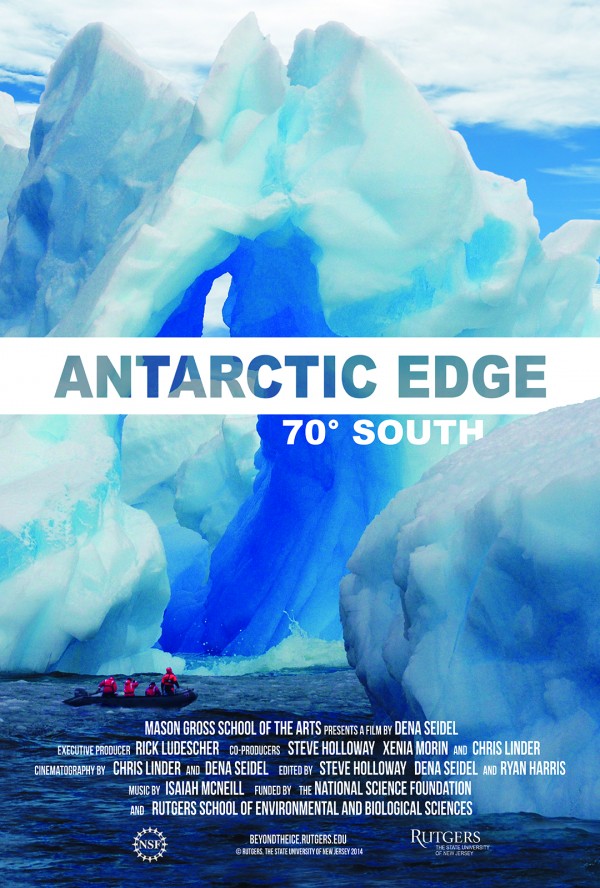PAOC Spotlights
Science Storytelling: 42⁰ North
Award-winning documentary filmmaker Dena Seidel uses art to communicate science. We sat down with Seidel during her visit to MIT to ask her a few questions about earth and ocean science filmmaking.
***
 Dena Seidel is an award-winning documentary filmmaker and director of the Rutgers Center for Digital Filmmaking. Her current project, Antarctic Edge: 70⁰ South, features the transformative science of the National Science Foundation’s Long Term Ecological Research (LTER) Project at Palmer in the West Antarctic Peninsula. In The Art of Science Filmmaking, an IAP lecture series hosted by the Department of Earth, Atmospheric, and Planetary Science, Seidel spent two days speaking with students and scientists about creating earth and ocean science narratives, as well as how scientists can partner with filmmakers to communicate science to large audiences. We sat down with Seidel during her visit to ask her a few questions.
Dena Seidel is an award-winning documentary filmmaker and director of the Rutgers Center for Digital Filmmaking. Her current project, Antarctic Edge: 70⁰ South, features the transformative science of the National Science Foundation’s Long Term Ecological Research (LTER) Project at Palmer in the West Antarctic Peninsula. In The Art of Science Filmmaking, an IAP lecture series hosted by the Department of Earth, Atmospheric, and Planetary Science, Seidel spent two days speaking with students and scientists about creating earth and ocean science narratives, as well as how scientists can partner with filmmakers to communicate science to large audiences. We sat down with Seidel during her visit to ask her a few questions.
1. How does your program use art to communicate science?
I am honored to be here, and I was thrilled to give these talks. I came to Rutgers as a filmmaker and an educator to design filmmaking classes for the students, but at the same time I was able to see and connect to a lot of research at the university. It wound up being a perfect match for my documentary film students who are looking for exciting subjects for their stories. Film students want authorship, creative control, high-quality cinematography and passionate storytelling that reaches a large audience. In our model, they do that while embedding the science in the story. We find this approach to be a really exciting and engaging way to reach a lot of people. Science communication is something that scientists may want to understand better—this ability to collaborate with artists, with both the scientist and the artist being creative partners in the design of artistic narratives that include science content. If you give authorship to young filmmakers, then they want people to see it so they’ll be communicating your science through their own social media and to their own peers. They’ll be communicating the research in a way that is stylized, appropriate, and relatable to a young audience.
2. What makes this model so successful?
The success of this model requires mutual respect between the scientist and the filmmaker. They have to come together on an equal level and respect each other as creative partners with a shared goal, and the scientists are always able to approve the representation of their science before the film is shown to the public. It provides a safe space and makes for a much better film because the scientists let their guard down and the filmmakers can capture real people that the audience can identify with, and that’s important in terms of attracting people to what it means to be a scientist.
3. What is unique about telling earth science and oceanography stories?
There are a lot of reasons why ocean and earth science is a perfect partner for filmmakers. It’s a subject that most people can understand needing to know more about. I always get excited when I communicate the most basic ocean science to a person in conversation. You realize that people don’t know 70 percent of the planet is covered by ocean; that the oceans are absorbing most of the heat from our sun; that they are a driver of our weather and climate change. When people think ocean they think beach, not life on Earth. When you present it that way, they get it pretty quickly. Caring about the ocean and the need to understand it is something most people can embrace. Also, so little of our oceans has been explored. All of this is very attractive to a large audience as well as young filmmakers. A lot of the scientists I’ve partnered with are biological oceanographers—they do field research at sea. And, we’ve had our students visit field sites as earth scientists build towers and collect data about the atmosphere. In the sense that we relate to the oceans, many people associate them with adventure and exploration, and I found most of the ocean and earth scientists to be very nice, relatable, and down to earth people. They partner well with the film students.
4. What is your advice for scientists interested in communicating their science to large audiences?
Scientists are trained to be objective, and their work is in pursuit of truth. They are collecting data that represent a truism about our world. In the arts, it’s about subjectivity and emotional expression—connecting people to each other through art and emotion. In the arts we talk a lot about emotional truth. The goals of science and art are very similar, but it’s the means by which we’re taught to shape our information that differs. If scientists and artists come together, then everyone has a creative voice. I encourage scientists to imagine a creative partnership with people who are trained in artistic expression who are also passionate about science learning. In terms of reaching a large audience, the model of merging art and science is very effective—you just need a space that encourages people to express science through art.
RELATED Links
Rutgers Center for Digital Filmmaking
[Video] Atlantic Crossing: A Robot's Daring Mission